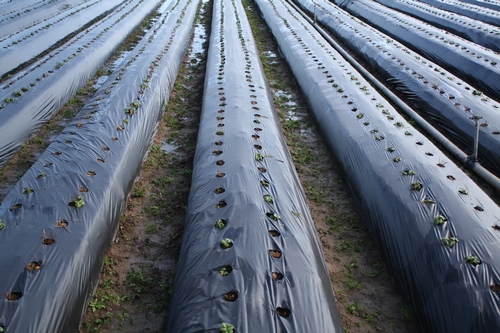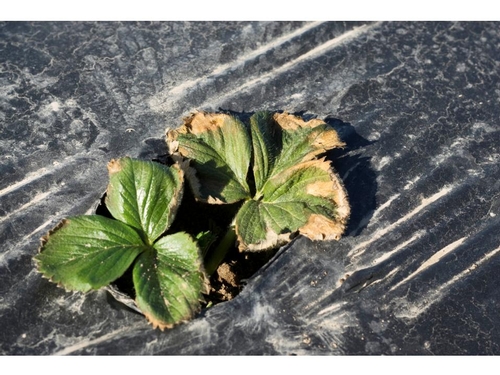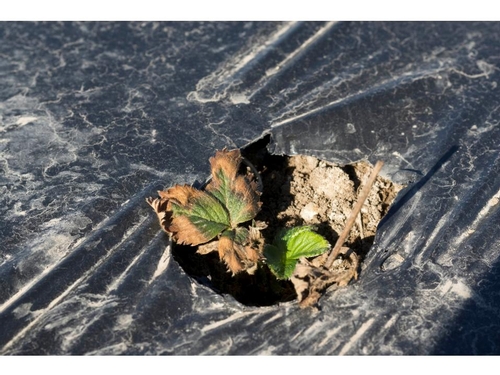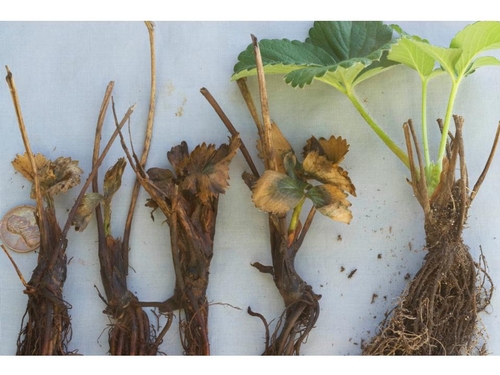Posts Tagged: ammonium
A Brief Overview of the Role of Manganese in Mitigating Soil Disease in Cultivated Plants including Strawberry.
I spent some time these past few days reviewing a chapter of the excellent publication Mineral Nutrition and Plant Disease. This book is a review of the scientific literature, and while we should not see any of this as recommendations for crop production practice, it does give us plenty to think about as far as what direction we can go experimentally:
Manganese (Mn) has a consistent record in the scientific literature as reducing vascular diseases in crop plants caused by soil pathogens such as Verticillium and Fusarium. Physiologically, this makes sense because of the role that manganese plays in the production of phenolic compounds, phytoalexins and other plant defense mechanisms.
An increase then in the amount of Mn applied to the soil (foliar applied does not work well, since Mn does not move downwards in the plant to the roots) seems to be a straightforward approach in obtaining the disease reducing qualities of this element into the plant. For example, one study (Dutta and Bremner, 1981), achieved greatly reduced Verticillium wilt by dipping tomato roots in a Mn solution before transplanting.
However, there are other strategies to increase plant tissue Mn, especially in the soil right around the roots. Lowering the pH of that soil through the use of ammonium fertilizers such as ammonium sulfate (ammonium acidifies more than nitrate), has reduced Verticillium wilt from moderately infested soils in eggplant (Elmer and Ferradino, 1994), and the combination of a rotation with oats with ammonium fertility (Elmer and LaMondia, 1999) has been shown to double the Mn tissue concentration in subsequent plantings of strawberry and reduce black root rot incidence (but not, unfortunately, increase plant growth or yield).
Again, some of this might be worth a look experimentally in strawberry on the Central Coast.
Several of the papers mentioned in the text above are available online – links provided below.
1. Dutta, B.K. and Bremner, E. 1981. Trace elements and plant chemo therapeutants to control Verticillum albo-atrum wilt. Z. Pflanzenkankh. Pflanzenschutz 88:405-412
2. Elmer and LaMondia. 1994. Comparison of Ammonium Sulfate and Calcium Nitrate Fertilization Effects on Verticillium Wilt on Eggplant. Plant Disease 78: 811-816 https://www.apsnet.org/publications/PlantDisease/
3. Elmer W.H. and LaMondia, J. A. 1999. Influence of ammonium sulfate and rotation crops on strawberry black root rot. Plant Disease 83: 119-123. http://apsjournals.apsnet.org/doi/pdf/10.1094/PDIS.1999.83.2.119
The Postscript to Last Week’s Blog Article about Salt Damage
As a postscript to last week’s post regarding salt and ammonium damage to area strawberry plantings, I will outline the results of the soil samples taken from a field demonstrating the symptoms described in that article.
Steve Koike and I collected soil samples from the affected field last Thursday, January 5. Soil samples were collected from four blocks, one of which had been overhead irrigated the day previous, and consisted of composites of at least five 5” deep samples taken from around the fertilizer band by the plant roots.
Samples were immediately taken to Soil Control Lab in Watsonville for analysis.
Results are as follows:
|
|
Nitrate (ppm) |
Ammonium (ppm) |
EC (dS/m) |
|
Sample 1 (not overhead irrigated): |
58 |
4.8 |
2.8 |
|
Sample 2 (not overhead irrigated): |
72 |
5.2 |
4.2 |
|
Sample 3 (not overhead irrigated): |
69 |
4.8 |
3.8 |
|
Sample 4 (overhead irrigated): |
24 |
5.1 |
2.2 |
The results are pretty clear in showing that the block (Sample 4 ) which had been watered by overhead irrigation had three times lower nitrate concentrations and about half the EC (which is electrical conductivity, a measure of salt) of the other three averaged as a group, but more equivocal on the reduction of ammonium.
To interpret the data in the table above, we can refer to work done some time ago which demonstrated EC’s in excess of 1.0 were related to loss in yield of strawberry, suggesting that real damage could occur at the 4x levels in the table above.
Early Season Dieback of Transplants in Central Coast Strawberries
Happy New Year everybody.
Unfortunately, we start out the year with some concerns. We want to alert growers that early in 2012 we are seeing transplant decline and dieback in various fields in the Watsonville-Salinas production district. As pictured below (Photo 1), this problem can be quite severe and characteristically affects a large percentage of the field. From what we have seen and heard from others, along with samples submitted to the UCCE disease diagnostics lab in Salinas, this decline is widespread and seems to be particularly acute in organic fields.
On closer inspection (Photos 2 and 3 below), the symptoms closely resemble those caused by high salt levels. Margins of the oldest leaves show the initial symptoms and become brown, dry, and burned. As the condition worsens, the entire leaf will wither and die. Eventually all leaves can turn brown and the transplant can actually die (Photo 4 below). Generally the internal crown tissue is sound and intact; however, as the plants continue to decline, some of these crowns turn brown and become discolored.
These transplant decline and death symptoms superficially resemble symptoms caused by Colletotrichum (anthracnose) and Phytophthora (crown and root rot). However, lab tests thus far have failed to recover any pathogen associated with these plants. In addition, the widespread (up to 75%, in some cases) incidence of declining transplants argues against a biotic agent as the cause of this problem. The problem appears to affect all cultivars and is not restricted to any one source of transplants.
What is causing all of this damage? For fields we have investigated, the water EC (electrical conductivity, a measure of salinity) is normal and the soil is not excessively saline and has never exhibited these symptoms before. Again, dieback symptoms are occurring across varieties, across nurseries, and across blocks. There is some indication that damage is more severe in wetter areas.
The exceptionally dry weather of the past five to six weeks may be playing a significant role in this development. The total lack of rain has forced strawberry growers to irrigate often, and in many cases this has been solely through the drip tape. While this amount of water is sufficient for plant needs, we should take into account that the beds are therefore not being leached by the abundant amounts of water that an inch or two of rain can bring all the while that the bands of pre-plant fertilizer amendments are accumulating salts around them and mineralizing into what can be predominantly ammonium forms of nitrogen in cooler soils. High levels of ammonium are associated with toxicity in plants, as are the accumulated salts.
So this leads us to believe that the leaf burn and transplant dieback being seen up and down our district is being caused by an accumulation of ammonium and salts around the roots because of a lack of leaching.
Interestingly, the most severe leaf burn problems have been in organic strawberry fields supplemented with pre-plant fertilizer. This pattern is consistent with what we know about these fertilizers, which are amendments such as blood or feather meal, meaning that they are fully mineralized in a matter of weeks after incorporation. Therefore, fields containing these fertilizers likely right now have significant amounts of ammonium accumulated in addition to the salts concentrated around the roots due to the lack of winter/spring leaching.
If our hypothesis is correct, growers who have this problem should counteract the buildup of harmful agents by irrigating with overhead sprinklers or at the very least with heavy watering through the drip tape. Overhead irrigation is a good substitute for rain and provides the abundant amounts of free water needed to move the ammonium and salts away from the plant roots where they are causing harm.

Photo 1. Large numbers of plants dying back in affected field. UCCE Santa Cruz County.

Photo 2. Early manifestation of plant decline. Courtesy Steven Koike, UCCE.

Photo 3. Severe manifestation of plant decline. Courtesy Steven Koike, UCCE.

Photo 4. Progression of decline with dead plant on the left and unaffected plant on the right. Courtesy Steven Koike, UCCE.

